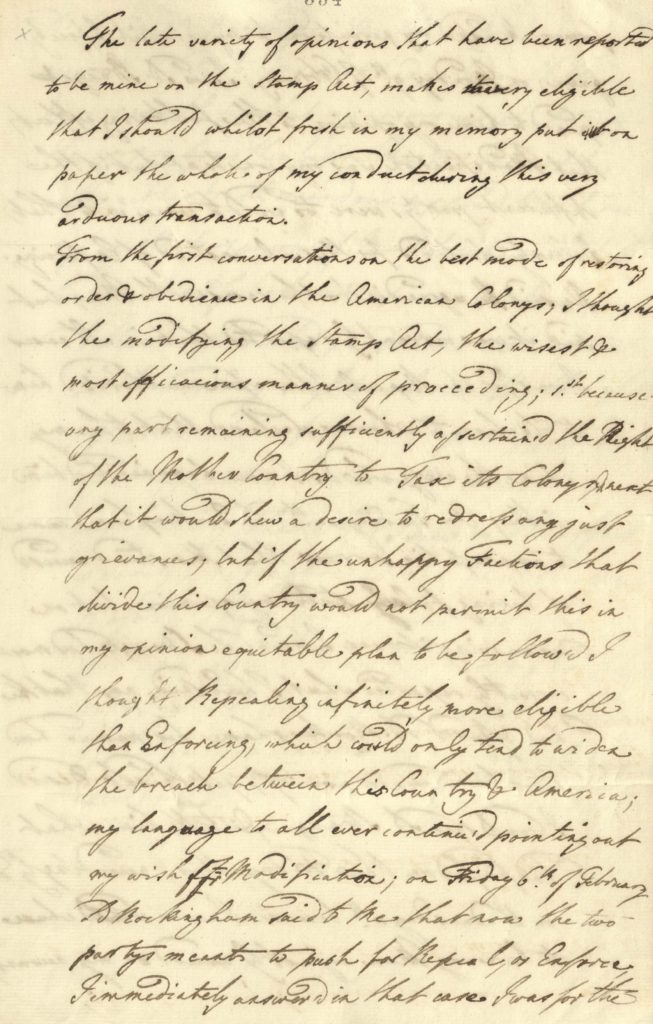
Michael Jibson as King George in the London production of Hamilton, 2018. Picture: Matthew Murphy
In the king’s first song he appears just after Alexander Hamilton’s rebuke of the American loyalist Samuel Seabury and defence of the right of an American Congress to assemble (1775). This is early in the American Revolution, and the tensions are a direct outcome of the conflicts over taxation of the colonies that result from the Seven Years War. That global conflict is a significant background to much of what happens in the early part of the musical.
1. The financial cost of the Seven Years’ War
Memorandum by George III on his actions relative to the Stamp Act [11 February 1766]
Georgian papers, GEO/MAIN/354
 The Seven Years’ War (1756-1763) was hugely expensive, not least because Britain had bankrolled its European allies participating in the European theatres of the war. Subsequently Parliament created a series of tax policies to raise revenue to pay down the national debt.
The Seven Years’ War (1756-1763) was hugely expensive, not least because Britain had bankrolled its European allies participating in the European theatres of the war. Subsequently Parliament created a series of tax policies to raise revenue to pay down the national debt.
The Stamp Act of 1765 generated unprecedented resistance among Americans and was repealed the following year, though the king and Parliament in repealing it restated their right to tax.
In this document, George III records his own thinking on repeal, characteristically and carefully charting his role in a key moment of crisis early in his reign which played an important part in the deterioration of Anglo-American relations.
Click on the document image to read it in full in high resolution.
Find it hard to read? Click here for a typescript of the document.
Click here to read the catalogue entry on the RCT website.
2. Logistics for colonial defence
Establishment of the Office of Ordnance, 1767-1771
Georgian Papers, EB/EB/46. Page 130, ‘Establishment at New York’.
The Ordnance Office was responsible for supplying gunpowder and shot to both the British Army and Royal Navy. This book lists every site where Ordnance officials were located both in Britain and overseas in 1767, detailing the names, status and pay of the personnel.
Stationing and provisioning troops in the North American colonies was essential business; it was welcomed by Americans during the Seven Years War, but considered a provocation by the time of the American Revolution.
The ‘James Furnis’ mentioned here as Comptroller of the New York Ordnance is also known as the author of an eye-witness account of the surrender of Fort William Henry in 1757 in his copybook, now in the William M. Clements Library at the University of Michigan. He took up this post in 1756.
Click on the document to browse the whole ordnance book in high definition.
Click here to read the catalogue entry on the RCT website
3. A global context
State of 5 battalions of Electoral troops sent in 1775 to Gibraltar and Minorca, with the names…
Georgian Papers, De Budé papers, GEO/ADD/15/0757
This is a report on the state of 5 battalions of troops from Hanover, George III’s ancestral German electorate, sent in 1775 to Gibraltar and Minorca, with the names of their Commanders, details of the colours of their uniforms and the numbers of officers, etc., in each battalion.
Click on the document to see the whole of it in high definition
Click here to read the catalogue entry on the RCT website
George III was managing a global empire, including recently resolved, or newly emerging military conflicts. George Washington, for example, had gained some renown as a British officer in the Seven Years War, a global conflict that included a significant North American theatre. Military planning and management, therefore, was a major concern of the king’s.
Many of the troops fighting his wars came from Germany, famously the Hessian troops who fought in the American War. Gibraltar and Minorca were key British outposts in the Mediterranean. The document is written in French, perhaps reflecting the fact that it is found among the papers of George III’s future aide-de-camp, General Jacob de Budé (1736-1812), born at Geneva and who had served both the Prince of Orange and in a Swiss regiment in Sardinia. At the time of this document’s creation, he was sub-governor to Prince William.
4. Planning the defence of the American colonies
Composition of the army and navy to be deployed in North America, 1775(?)
Georgian Papers, GEO/MAIN/2277
This memoran dum was written by George III himself, probably in 1775, to outline the requirements for a North American war. As unrest bubbled with increasing vigour in some of the American colonies, the king and his ministers began to organize a stronger military presence there to maintain control. The armies under discussion here are sizeable.
dum was written by George III himself, probably in 1775, to outline the requirements for a North American war. As unrest bubbled with increasing vigour in some of the American colonies, the king and his ministers began to organize a stronger military presence there to maintain control. The armies under discussion here are sizeable.
In this document the king directed his keen attention to the defence of British interests and territory by enumerating ‘the number of troops to be employed.’ This is but one example among many in the papers where the king personally recorded minute details of military and naval forces (note he gets down to ‘waggons’ and ‘harness’) both of his own and of his enemies, and also is representative of his more general care for detail and analysis.
To see the full document in higher definition, click on the image.
Click here to read the catalogue entry on the RCT website
Find it hard to read? Click here for a typescript of the document.
Move on to part 2 of the Exhibition: ‘What Comes Next?’


